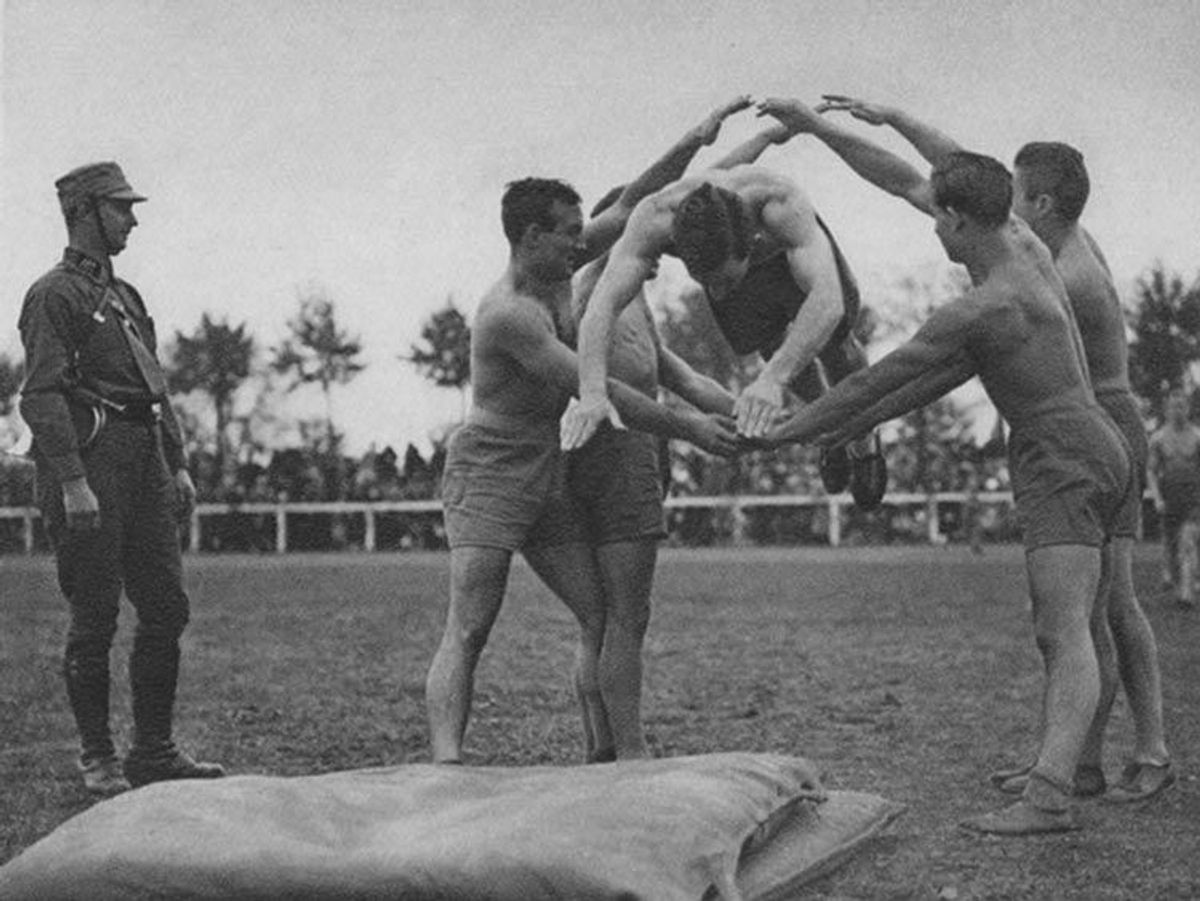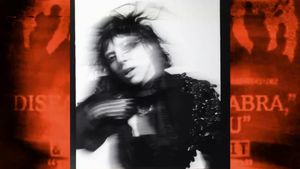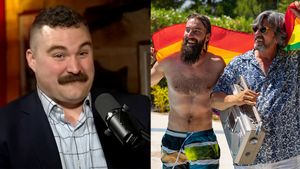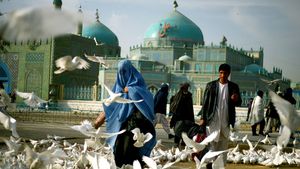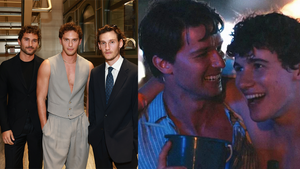The ridiculous notion that "the Nazi party was entirely controlled by militaristic male homosexuals," as was posited in a book by antigay activists Scott Lively and Kevin Abrams in their 1995 book The Pink Swastika, has been furthered by the likes of leading homophobes Pat Robertson and Bryan Fischer. And the fallacy has persisted, but now a new book undermines it.
Author Andrew Wackerfuss debunks this myth of the so-called pink swastika in his book, Stormtrooper Families: Homosexuality and Community in the Early Nazi Movement, which provides, as the New York Journal of Books notes, "a much-needed historical reckoning against falsehoods."
Taking an academic approach using extensive archival material, Wackerfuss employs the anthropological meaning of "family" as a basic organizing structure in human societies in which relationships define the obligations, rights, and appropriate interactions of a group's members. In doing so, he provides a fascinating glimpse into Germany's deeply schizophrenic elite military unit. Simultaneously homosocial and homophobic, it harbored only a handful of gay men in its ranks; the stormtroopers were later cast by Adolf Hitler as a brotherhood of degenerates so that he could justify a bloody purge and intense surveillance of even straight citizens' sexualities in Germany.
Tying those dark days into more recent history, Wackerfuss reveals how homophobia was -- and remains -- an insidiously effective political weapon.
Using diary entries and archival news reports from the decade between the World Wars, Stormtrooper Familiesreveals intimate details about the lives of the men who served in the famously cliquish, violent, and chaotic German military unit known as Sturmabteilung (a.k.a. "SA" or "Stormtroopers"). Wackerfuss shows that the relationships among the all-male SA were far more bromance than romance.
As in many of the male-only military units in the 20th century (including within the U.S. Army), there was little overt homosexual activity, despite the often homoerotic nature of the homosocial environment. That doesn't mean there weren't gay stormtroopers, though. With its reputation as a fiercely masculine organization, the SA attracted a diverse cross section of men, many of whom came from disadvantaged backgrounds, some who felt a need to "prove" their manhood, and many who longed to be part of a brotherhood. Some of those men were gay or bisexual, but their presence among the stormtroopers paradoxically furthered Nazi queer-baiting and homophobic justification of violence.
But Stormtrooper Families is not just a book about an elite military unit between the World Wars. Wackerfuss cleverly illustrates how those events and these types of homophobia have reverberated through time, shaping political arguments that are still common today.
Pointing to instances where modern-day neo-Nazis have come out or been outed as gay -- including leading figures in the National Socialist Party of America, Germany's neo-Nazi underground, and the British neo-Nazi movement -- Wackerfuss writes, "Modern psychological studies have identified this dynamic as a process of reaction formation, in which people with intense resistance to their own same-sex desire proclaim vehement opposition to homosexuality, hoping thereby to convince both others and themselves of their heterosexuality. The concept has long-standing support in psychological theory, as well as in historical experiences throughout the modern era."
Below is an exclusive edited excerpt from Stormtrooper Families: Homosexuality and Community in the Early Nazi Movement, in which Wackerfuss provides a brief history of homosexuality and homophobia in the Nazi SA.

In pre WWII Germany, as now in the US, fear of political and economic crisis often intensified existing social panic about increasing rates of divorce, unwed motherhood, abortion, venereal disease, homosexuality, and other alleged symptoms of "degeneracy."
Alarmed youths joined the nascent Nazi movement, which had positioned itself as a self-consciously pro-family party whose earliest meetings and events showcased marriage, family, and respectable domestic life. Yet the stormtroopers also loudly proclaimed their allegiance to an all-male lifestyle, which they had honed during the Great War and now continued to rely on for emotional stability in an unstable world. They therefore existed uncomfortably between two competing kinship networks -- one familial, one comradely. The tension between the two became one of the most important characteristics of the movement.
The SA sought to establish the stormtroopers as responsible young men, while on the other it hoped to strengthen the brawling same-sex society that had brought the movement this far. At the same time, the rush of victory attracted a new wave of self-interested recruits who knew little of the emotional and spiritual foundations of the stormtrooper lifestyle and instead sought only their own advantage. Victory therefore brought more grief than solace to many SA men, who now faced the irreconcilability of their two families as never before.
Stormtroopers lead two paradoxical family lifestyles. They married, they founded their own families, and they claimed to be entering politics in order to protect the traditional nuclear family, while at the same time, they actively sought to live as soldiers, disconnecting from their families in favor of their comrades, embracing violence and combat, and at times demonstrating so much affection with one another as to call their sexual preferences into question.
In the past, male-bonding was never looked at suspiciously. In the Weimar era, German homosexual rights groups were the largest and strongest in the world. The homosexual scene in Berlin became a prominent feature of German culture. Homosexual bars and taverns opened in most major German cities, including Hamburg. The public was becoming aware of homosexuals in their midst. What was once an innocent hug, arm around the shoulder, or horseplay from their segment of homosexual sub-culture was now suspect of being something more despicable.
The conflict came to a head in 1928, when a murder trial outed a stormtrooper as homosexual. The SA then sought absolution through a public protest against a play, The Criminal, which demonstrated a tolerant stance toward homosexuality. This became a flashpoint the SA used to unite the radical right's squabbling factions under the stormtrooper banner.
The stormtroopers' communal living spaces tried to root them in neighborhood and family life, but the homoeroticism, drunkenness, and debauchery found there bred conflict with more socially traditional and family-oriented wings of the Nazi movement. The tensions increased as a small number of homosexuals within the SA leadership became known, which led to the political left's increasing eagerness to challenge the Nazis' sexual self-image.
Tensions between same-sex camaraderie, revolutionary demands, and the SA's new pretension to legitimate authority reached a head by mid-1934. The stormtroopers' loud insistence on their honor and privileges, their rampant corruption and excess, and their continued use of violence in public spaces now threatened to undermine the Nazi movement. Hitler and his cronies took action, purging the SA of its leaders and settling old scores in a national massacre that lasted for days.
Hitler then mobilized political homophobia as his prime justification for the purge, arguing that he had acted to extirpate the rot of homosexuality from SA and party ranks. Now that the group was cleansed, he said, every German mother could again feel safe with the party in charge. The stormtroopers had thus fallen victim to sexualized political paradigms that they themselves had strengthened.
After June 1934, not only were homosexual stormtroopers (who had been accepted or lived undercover) chased out of the organization, all SA men were now under the scrutiny of a Nazi Party able and eager to police its citizens' sexual morality and family circumstances. In other words, the authoritarian family policies the Nazis later imposed on all Germany came first to the stormtroopers.
In 1935, the regime chose the anniversary of the purge to publish its extended version of P175, which expanded the category of the crime far beyond "actions resembling coitus," the previous standard. Now, Nazi judges could decree any act -- even a simple touch or look -- as evidence of homosexuality. The situation had become so inflamed that denouncers even began to consider negative interest in homosexuality as evidence of same-sex orientation.
The SA resolved to prevent any association between itself and homosexuality in the public mind. It did so first by hunting down its own homosexual members, no matter how valuable their service had been. Hitler ordered the SA cleansed of any association with homosexuality, whether proven or alleged. Yet even heterosexual men now discovered that the Party and the SA intended to monitor their sexual lives and their family relationships as well.
Stormtrooper Families is from Harrington Park Press, a specialized scholarly book publisher devoted to emerging LGBTQ topics.
